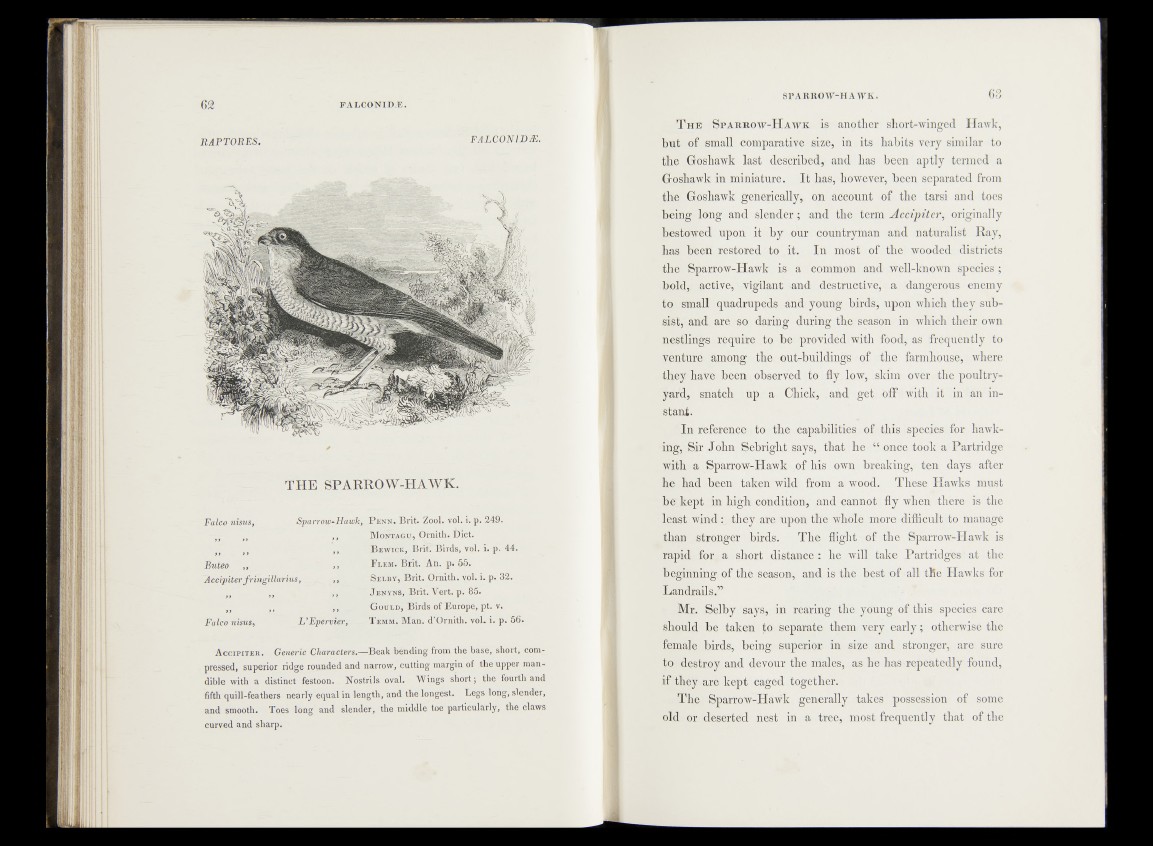
FALCONID.E.
RAPTORES, FALCON1DM
T H E SPARROW-HAWK.
Falco nisus, Sparrow-Hawk, P enn.t) Brit. Zool. vol. i. p. 249. ,, Montagu, Ornith. Diet.
,, B ewick, Brit. Birds, vol. i. p. 44.
Buteo „ ,, F lem. Brit. An. p. 55.
Accipiter fringillarius, ,, Selby, Brit. Ornith. vol. i. p. 32.
,, ,, J enyns, Brit. Vert. p. 85.
,, ,, Gould, Birds of Europe, pt. v.
Falco nisus, L ’Epervier, T emm. Man. d'Ornith. vol. i. p. 56.
A ccipiter. Generic Characters.—Beak bending from the base, short, compressed,
superior ridge rounded and narrow, cutting margin of the upper mandible
with a distinct festoon. Nostrils oval. Wings short; the fourth and
fifth quill-feathers nearly equal in length, and the longest. Legs long, slender,
and smooth. Toes long and slender, the middle toe particularly, the claws
curved and sharp.
T h e S p a r r o w - H a w k is another short-winged Hawk,
but of small comparative size, in its habits very similar to
the Goshawk last described, and has been aptly termed a
Goshawk in miniature. It has, however, been separated from
the Goshawk generically, on account of the tarsi and toes
being long and slender; and the term Accipiter, originally
bestowed upon it by our countryman and naturalist Ray,
has been restored to it. In most of the wooded districts
the Sparrow-Hawk is a common and well-known species ;
bold, active, vigilant and destructive, a dangerous enemy
to small quadrupeds and young birds, upon which they subsist,
and are so daring during the season in which their own
nestlings require to be provided with food, as frequently to
venture among the out-buildings of the farmhouse, where
they have been observed to fly low, skim over the poultry-
yard, snatch up a Chick, and get off with it in an instant.
In reference to the capabilities of this species for hawking,
Sir John Sebright says, that he “ once took a Partridge
with a Sparrow-Hawk of his own breaking, ten days after
he had been taken wild from a wood. These Hawks must
be kept in high condition, and cannot fly when there is the
least wind : they are upon the whole more difficult to manage
than stronger birds. The flight of the Sparrow-Hawk is
rapid for a short distance : he will take Partridges at the
beginning of the season, and is the best of all the Hawks for
Landrails.”
Mr. Selby says, in rearing the young of this species care
should be taken to separate them very early; otherwise the
female birds, being superior in size and stronger, are sure
to destroy and devour the males, as he has repeatedly found,
if they are kept caged together.
The Sparrow-Hawk generally takes possession of some
old or deserted nest in a tree, most frequently that of the